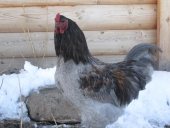Adam Klaus wrote:
Dave Hawkins wrote:I wouldn't mind 5 months if I'm not buying feed.
The reason I have chosen to utilize a slow growing breed is actually for its economy in feed.
Fast growing birds require high protein commercial feeds, which are expensive.
Slow growing birds can grow much more economically on forage, with a relatively small supplementation of whole grains.
My total feed costs end up being less than $1 per pound of dressed bird. With organic feeds.
Its like the tortoise vs the hare, slow and steady wins the race.
Looking forward to your answer on that last reply. This one is the deconstruction; let me know if I got it wrong somewhere.
In the linked thread you said it took 21# of feed to get a bird to 20 weeks with a 4 to 5# dress weight.
My last batch of Rainbows from Mt. Healthy took 24lbs of feed to about the same size as yours but did it in 17 weeks and that result was fairly error prone; there was lots of room to improve significantly. At 21lbs of feed/bird you're not really saving much feed and feeding way more than an 8 week cornish cross would require. Is it sustainable to double the land required to grow chicken feed? But it is cheaper feed and the result is higher quality. In reality your 21lbs of feed is only the energy protein and a complete feed equivalent would be 32 lbs of a corn/bean ration. IOW, way way less efficient.
But herein is a HUGE bugabo. If you're feeding dryland CO/WY spring wheat instead of corn, that will be 14-16% (vs. 8% for corn). I grew up in MT and we'd feed straight wheat to layers with better results than folks here in KS get on mixed/balanced feed despite the worse winters up north. In other words, it has almost all the bulk protein you need (though not balanced at the AA level) and is very nutrient dense and so you need very little from pasture. Clover and fermented milk out to easily balance most of the rest of the AAs. But if someone out east tries to grow birds or produce eggs on pasture with 10% winter wheat its going to fail; hard!
Welp claims 10lbs and 6 weeks to produce a CC. My local organic grain is $.54/# (a typical midwest organic price) before shipping so thats $5.40/bird. Local corn is .38 and wheat .2948/#. So going with wheat for yours thats $6.1908/bird BEFORE skim milk and extra labor cost of sprouting and fermenting and the extra labor and opportunity cost in tripling your time to market. But with 5# dress you're still at $1.24 on just the grains. Not under a dollar by any means. Last years wheat price would have pulled it down to $.97; but thats before your extra labor involved with sprouting/fermenting which must be included for an apples to apples comparison. Welp says 17# and 12 weeks for a Red Ranger which is probably accurate. That would be $9.18/bird on mixed organic feed. How that compares to your bird will depend on the time inputs involved in your alternative feed regime. Now grow a hand harvestable OP variety of corn that pushes 12%p and use that with your regime and you might have a winner from a sustainability standpoint.
So it doesn't look as rosey a picture as you paint. BUT if your numbers are accurate then it looks like marketing heritage birds is at least doable; which is something as the only one I've known thus far who has pulled it off is Frank Reese and he requires quite a premium to do it. A true breeding meat bird with high quality carcass is a huge missing piece of the sustainable puzzle and I'm thrilled to see you taking a crack at it. Though from a business standpoint I don't look at it as a way of saving money as breeding and hatching takes time and on a small scale should be more expensive than hatchery birds. But it is very useful as a way of reducing risk, controlling quality, and increasing profits through vertical integration. And on a sustainability/societal level we need to break free of the dependence on large multinationals for our chicks.
However if you're feeding western dryland wheat I don't think the birds are really getting all that much from the pasture.






